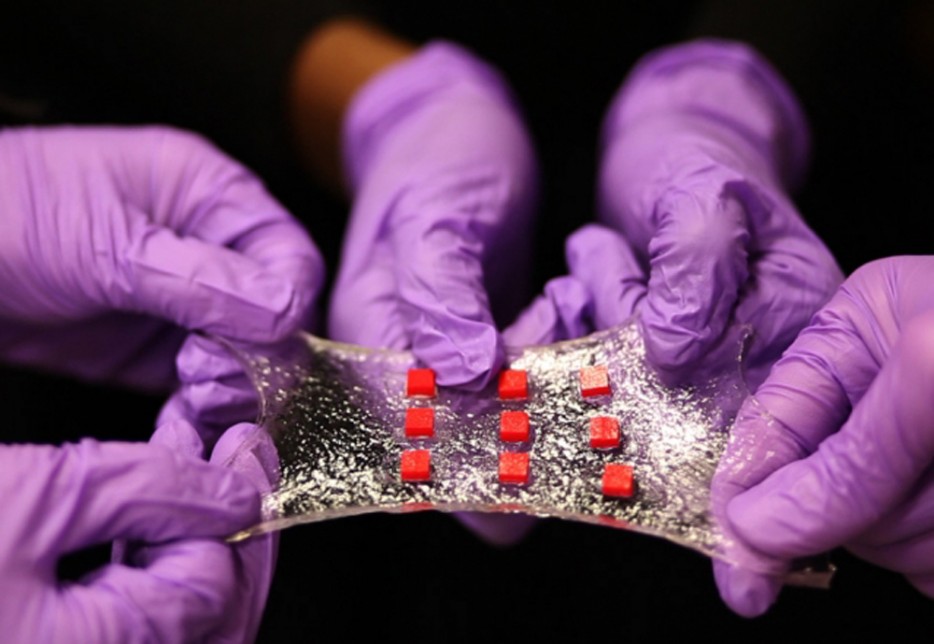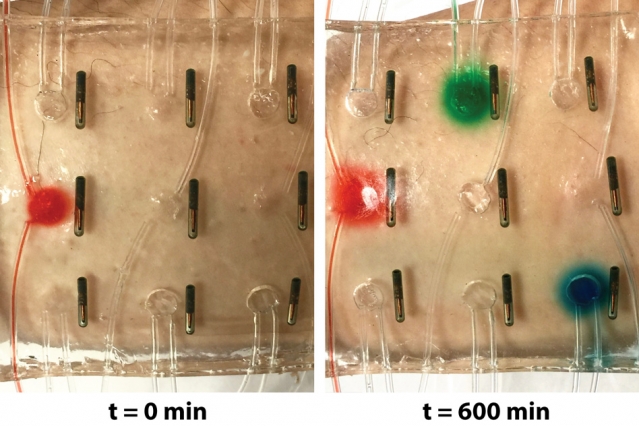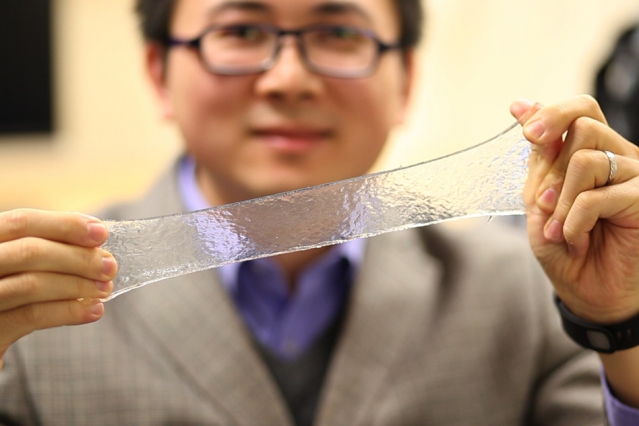Ladies and gentlemen, I present to you: the Band-Aid of the future.

This stretchy Band-Aid is equipped with LEDs, sensors, and drug delivery channels. Image source: MIT.
Invented by researchers at the Massachusetts Institute of Technology (MIT), this modern Band-Aid is made of stretchy hydrogel that’s embedded with LEDs, temperature sensors, and drug delivery channels that act depending on the person’s skin temperature to aid in wound healing.
Designed by Xuanhe Zhao, the Robert N. Noyce Career Development Associate Professor in MIT’s Department of Mechanical Engineering, the hydrogel is a rubbery material, mainly composed of water, meant to bond to surfaces such as gold, aluminum, titanium, silicon, glass, and ceramic.

A stretchable, hydrogel wound dressing includes temperature sensors and drug-delivery channels and reservoirs, embedded in a hydrogel matrix. Image source: MIT.
“Electronics are usually hard and dry, but the human body is soft and wet,” Zhao said. “These two systems have drastically different properties. If you want to put electronics in close contact with the human body for applications such as health care monitoring and drug delivery, it is highly desirable to make the electronic devices soft and stretchable to fit the environment of the human body. That’s the motivation for stretchable hydrogel electronics.”
According to Zhao, typical synthetic hydrogels are brittle, barely stretchable, and adhere weakly to other surfaces. “If you want to make an electronic device out of hydrogels, you need to think of long-term stability of the hydrogels and interfaces,” he said.

Professor Xuanhe Zhao holding the hydrogel. Image source: MIT.
To get around these challenges, Zhao and his team came up with a design strategy for robust hydrogels by mixing water with a small amount of selected biopolymers to create soft, stretchy materials with a stiffness of 10 to 100 kilopascals — about the range of human soft tissues. The researchers also devised a method to bond the hydrogel to various nonporous surfaces.
As part of their study, the researchers applied their techniques to demonstrate several uses for the hydrogel, including encapsulating titanium wire to form a transparent, stretchable conductor. They stretched the encapsulated wire multiple times and found that it maintained constant electrical conductivity.
Additionally, Zhao created an array of LED lights embedded within a sheet of hydrogel. When attached to different areas of the body, the array continued working, even when stretched across deformable areas such as the elbow and knee.
Lastly, the group embedded various electric components within a sheet of hydrogel to create what they call a “smart wound dressing,” compromised of temperature sensors and tiny drug reservoirs. Pathways for drugs to flow through the hydrogel were also created, either by inserting patterned tubes or drilling holes through the matrix. When placed over different regions of the body, the dressing continued to monitor skin temperature and release drugs according to the sensor readings, even when highly stretched.
Zhao envisions hydrogel to be a biocompatible vehicle for delivering electronics inside the body. Currently he’s exploring hydrogel’s potential as a carrier for glucose sensors, as well as neural probes.
“The brain is a bowl of Jell-O,” Zhao said. “Currently, researchers are trying different soft materials to achieve long-term biocompatibility of neural devices. With collaborators, we are proposing to use robust hydrogel as an ideal material for neural devices, because the hydrogel can be designed to possess similar mechanical and physiological properties as the brain.”
Source: MIT
Advertisement
Learn more about Electronic Products Magazine





